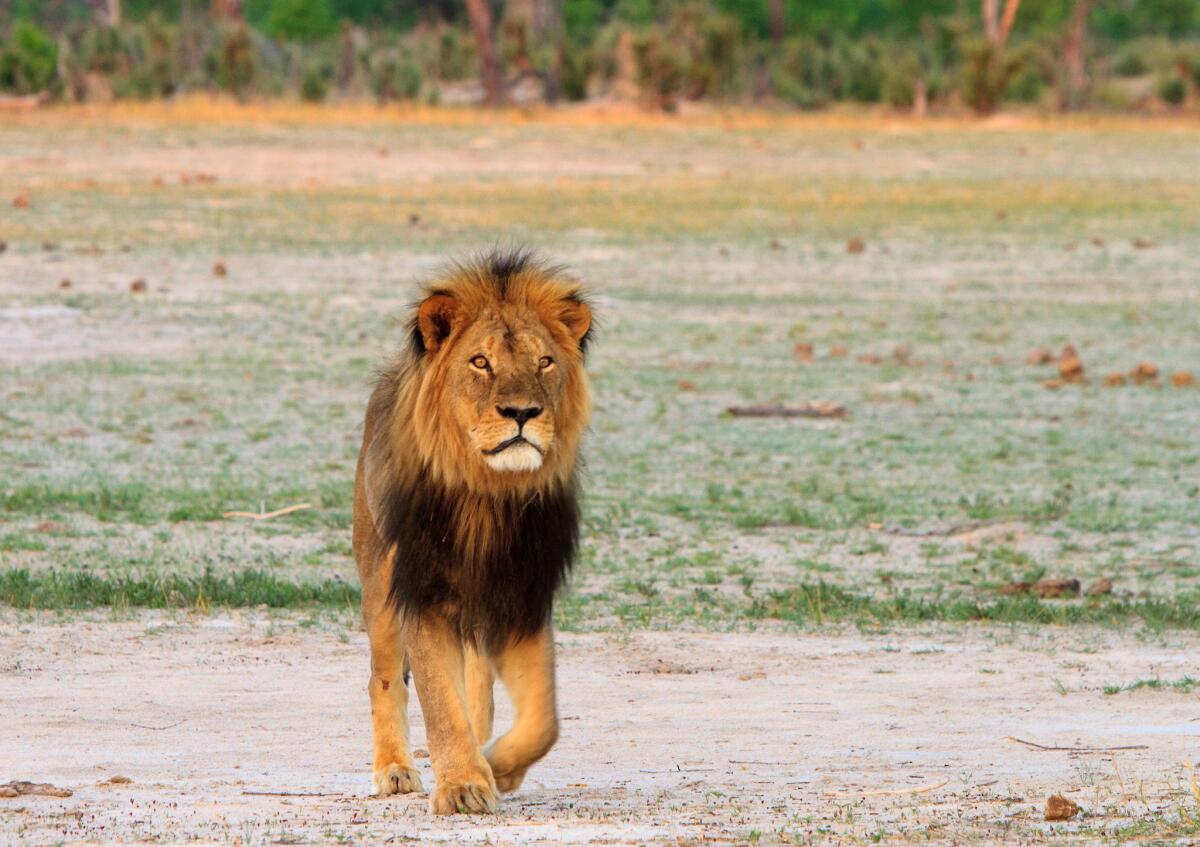Op-Ed: Why allowing trophy hunting is good for endangered species

Cecil the lion roams on the plains in Hwange National Park on Nov. 18, 2012, in Zimbabwe. In July 2015, an American dentist named Walter Palmer killed Cecil during a trophy-hunting trip.
- Share via
The controversy over the slaying of Cecil the lion in Zimbabwe in July has mainly centered on whether Walter Palmer, the Minnesota dentist and hunter who killed him, should be hanged (as advocated by People for the Ethical Treatment of Animals) or merely have his dental practice destroyed (as already seems to have happened). As reprehensible as Palmer may be, that debate is far too simplistic. What’s at issue in the Cecil affair is nuanced and complicated. It’s this: Is “trophy hunting” -- the bagging of large, rare, sometimes endangered animals for the thrill and a head to hang on one’s wall -- evil, or is it actually good for the future survival of the animal’s species?
The answer to that latter question seems to be yes, if a highly qualified yes. The economic incentive implicit in allowing hunters to pay steep prices to get a trophy seems to work better to preserve species than simply banning such hunting altogether.
Case in point: the African white rhinoceros. Along with its cousin, the black rhinoceros, the white rhino is one of the Big Five trophies (the lion is another) that big game hunters crave to kill. They are impressive animals. The rhinoceros, black or white, is Earth’s second-largest land mammal, and its primary predator is humans.
And indeed, thanks to uncontrolled sport hunting during Africa’s colonial period, by the end of the 19th century there were only about a hundred left of one subspecies, the southern white rhino, out of the hundreds of thousands that once roamed the bottom third of the continent. White rhinos now enjoy protected legal status in every African country, and their numbers are back to more than 20,000, but they face another threat of extinction: rampant illegal poaching, often by organized crime syndicates using helicopters and high-tech equipment. Powdered rhinoceros horn, a widely used folk-medicine in East Asia, is a highly profitable commodity.
The country with the best track record for protecting the white rhino is South Africa, where 16,000 of the 20,000 live. That’s because South Africa allows farmers to “own” wild animals on their property. They can within certain rules capture and sell the rhinos (and other game animals) and their offspring, open the grounds to tourists, and charge hefty fees for a limited amount of trophy hunting. An Aug. 7 article on the Voice of America website reported that hunting is now a $744-million business in South Africa, employing 70,000 people.
The success that South Africa and other African countries have enjoyed with sustaining wild-animal populations via property rights has led several conservation organizations, including Save the Rhino and the World Wildlife Fund, to endorse such rights and supervised hunting as a strategy for preserving biodiversity.
As the Economist, in a 2010 article, pointed out, without the wild paying its way through something like supervised hunting, there’s little incentive and plenty of disincentive for the people who must live among exotic animals to care about their survival. Giraffes look cute to us Westerners, but for Masai cattle-herders in Kenya, they’re competition for water. A single elephant can devour or trample an African farmer’s entire crop overnight. As Goodwell Nzou, a Zimbabwean grad student in the U.S., pointed out in the New York Times on Aug. 4, villagers in his country cheer, rather than mourn, when a lion is killed. They understand that lions are 400-pound apex predators that can rip apart their livestock and their children.
Furthermore, it is often hunters who do the most to preserve the species they hunt. This isn’t irony, it’s logical. Ducks Unlimited, a waterfowl-hunters nonprofit, has conserved more than 13 million acres of U.S. wetlands and grasslands -- habitat crucial for waterfowl and many other creatures -- mostly through buying easements and offering other financial incentives to the private owners of those properties.
This is not to say that trophy hunting, especially in a poor country such as Zimbabwe, isn’t fraught with temptations to corruption. South Africa has had problems with rhino poachers passing themselves off as bona fide hunters. More subtle is the temptation for landowners and professional guides to cut corners, legal and otherwise, to provide their wealthy clients with an ego-gratifying experience.
Trophy hunting -- killing wild animals for reasons other than one’s immediate safety or as a source of subsistence -- is as old as human history. (Think of the jaguar pelts that Mayan kings sported, or the tusk-scar that Homer’s Odysseus acquired in a boyhood boar-hunt.) It has always been associated with men (and a few women) of high social status and massive self-regard. And it has never been hard to see its troubling undertones. In Ernest Hemingway’s 1935 masterpiece of a hunting story, set in Kenya, “The Short Happy Life of Francis Macomber,” the professional guide unsportingly (and illegally) chases down buffalo for his rich American clients in a car.
Allegedly, legal rules and the rules of sportsmanship were broken in the case of Palmer, who paid $50,000 to bag the lion that turned out to be Cecil. Reports say the lion was lured from a national park, where he was protected, with bait in the form of a freshly slaughtered animal. Palmer wounded him with a crossbow and Cecil had to be tracked for 40 hours before he could be finished off with a gunshot. Palmer and company removed a tracking collar from the animal, which they apparently tried to hide. It doesn’t help that the dentist already had pleaded guilty to lying about the illegal killing of a black bear in Wisconsin in 2006.
The unsavory facts surrounding the Palmer case have led to calls by animal-rights activists for bans on all trophy hunting; major airlines say they will no longer accept heads and skins of trophy animals as cargo. But the alternative to trophy hunting probably would be worse: The inexorable extinction of lions, rhinos and other magnificent beasts in the wild because few have the incentive to keep them alive.
Charlotte Allen is the author of “The Human Christ: The Search for the Historical Jesus.”
Follow the Opinion section on Twitter @latimesopinion and Facebook
MORE ON CECIL THE LION:
Readers fume, muse on the killing of Cecil the lion
The lesson of Cecil: Big-game trophy hunting should be outlawed
Outraged over Cecil the lion? It may help you understand the rage over Planned Parenthood
More to Read
A cure for the common opinion
Get thought-provoking perspectives with our weekly newsletter.
You may occasionally receive promotional content from the Los Angeles Times.









